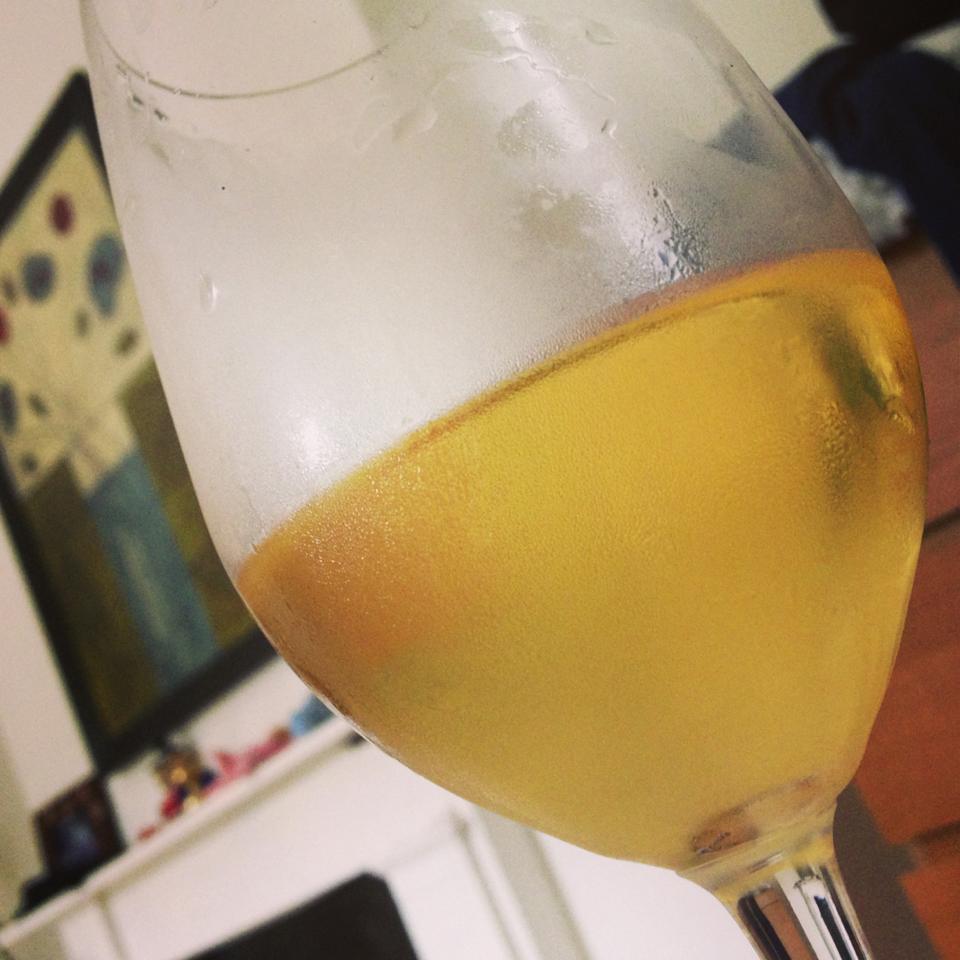I am really enjoying skin contact whites at the moment. These are white wines that are made like red wines, with the skins present during the fermentation, rather than pressing the juice off before fermentation begins.
As I write I am drinking Tom Shobrook’s Giallo, and loving it. It’s an Aussie skin-contact Sauvignon Blanc, and it shows amazing aromatics – floral, delicate, apricot, passionfruit, citrus. On the palate there’s a lovely spicy, slightly grippy twist and nervy acidity that counter the fruitiness just beautifully. It’s profound.
But skin contact whites are niche, operating outside the fine wine mindset. I think this could be about to change: these wines are frequently compelling. I don’t know why they don’t enjoy greater support.
Some skin contact whites can be heavy, tannic and clumsy. Frequently, though, they show beautiful delicacy and poise. They are often aromatically thrilling. The best ones show beautiful aromatics and manage the tannins from the skins really well.
The period of skin contact can vary quite a bit: I have had a wine that spent two years on the skins, but some will just spend a few weeks (as red wines typically do, before pressing). This alters the character of the wine.
The term ‘orange wine’ has been coined for skin contact whites, because they often take on an orange colour. But not all of them do: this Giallo is a regular sort of yellow colour. The orange may come from oxidative ageing with the presence of phenolics in the wine.
It would be great to put on a tasting of the best skin contact whites to convince the sceptics because these are some of the most profound of all wines.
12 Comments on Skin contact whites, the next big thing



We have been traveling to wineries and vineyards in Georgia (Sakartvelo) the last two weeks. They have been growing grapes and winemaking for the last 8,000 years. The traditional winemaking technique is to place juice and chacha (pomace) in a qvevri, an earthen vessel for fermentation and aging wines. We have had some amazing white wines that were fermented and aged on their skins, seeds, jacks and sometimes stems.
If you like red wines with tannins, try some of the white wines produced in Georgia with tannins. The range from mild tannins to very bold tannins. Most white wines made in qvevri are gold to dark amber in color.
Funny you should write this now, we’re actually tasting a big line-up of Orange wines this Thursday at our shop in Hackney, London. Predominantly great wines from Friuli, but also ft. Solvenia, Germany, and more.
Here are the details: http://t.co/hIwuPsh5RW
A few places left, but if you’d like to come drop us an email.
Cheers,
-James
Please no! When cortese, sauvignon, and ribolla all taste the same due to skin contact and “natural” winemaking, you loose all sense of varietal and terroir. Not to mention so many of the flaws that go along with skin contact whites… VA, oxidation, etc.
This trend has a been a sommelier fad for a couple years now and, not surprisingly, has not been picked up by consumers. The wines languish by-the-glass, causing the business losses. Get over the fad – it’s not catching on for a reason!
Yohannah,
You are entitled to your opinion, but you should be aware that it’s not a fad! White wines have been made in this way for thousands of years in the Caucasus and at least for hundreds of years in Spain and Italy. No doubt, these types of wines will always be very niche and for wine-geeks, but I personally don’t care whether they are in or out of fashion at any given time! Like any wines, I think they should be enjoyed (or criticized) on their own merits, not according to whether they are in fashion or not. Cheers, enjoy a good one if you can find one, which may be difficult if you don’t happen to live in New York, London or Tokyo!!!
I wish there were more skin contact whites that were made with sulphur and possibly with non oxidative ageing. The phenolics are interesting, but personally I can usually do without the volatility that so many orange wines have.
Some of my favourite reds are made in amphorae with sulphur – no vanilla boringness but the same softening effect of some oxygen. Gives purity to the wines without the instability and allows them to retain their terroir differences.
I think there is a lot of potential in the use of long skin contact in producing white wines. You have to get around the perception that higher levels of phenolics don’t belong in a fine white wine, which I believe is nonsense. If the wine is balanced and complete, the phenolic edge can be intriguing and invigorating to the wine. Along with the phenolics, you extract a lot more from the skins when fermenting on them, so you have the potential to create very complex wines (with a niche following, for now).
I find that as my palate develops, I look for this kind of ‘edge’ as it adds interest and another dimension. Makes for a much more compelling glass of wine.
Jamie,
Interesting point! There is of course no reason why skin-contact whites should be oxydized or have a high VA or be sulphur-free. Perhaps it’s because the only winemakers who make skin-contact whites happen to be makers of ‘natural wine’!!! I may well do an experiment with SO2 this year! 🙂
Jamie,
Off and on for the past two years, I have been on a quixotic quest to answer this question:
“Does anyone use carbonic maceration to make WHITE wine?”
I have asked this question of enology professors, winemakers, Masters of Wine, Master Sommeliers, wine writers and wine merchants.
And to a person the unanimous answer is “No.”
On the face of it, it seems counter-intuitive.
But suspend your disbelief for a moment and probe deeper.
Two mainstream white wine grapes — Pinot Gris and Gewurztramer — have, owing to their pink or even red skin color, corresponding skin tannins.
Carbonic maceration (a common practice in Beaujolais) seeks to avoid the extraction of tannins.
Seems like a reasonable technique for avoiding tannins when making Pinot Gris and Gewurztraminer . . .
I have found at least one American winery (in Oregon) using partial carbonic maceration when making their Pinot Gris: Johan Vineyards.
[Link: http://www.johanvineyards.com/accolades.asp?ID=12%5D
Your thoughts?
Your readers’ thoughts?
~~ Bob
Hi Bob,
I made some Airén a few years ago using carb.maceration. This year I’m doing an experiment with a white grape called Chelva. There’s about 300 kg fermenting carbonically right now!!!
Fabio,
Thank you for your reply.
Not being familiar with Airén, I went looking for some self-education on the Web.
Quoting Wikipedia:
“The grapes … have a yellowish color.”
— and —
“In Jancis Robinson’s ‘Guía de Uvas para Vinificación’ (1996) Airén is cited as the most grown variety of grape in the world: with 423.100 ha under cultivation … She comments that it is the most common variety in Spain, comprising 30% of all vines. …”
[Link: http://en.wikipedia.org/wiki/Air%C3%A9n%5D
Based on the grape’s skin color, I surmise you didn’t adopt carbonic maceration to minimize tannin extraction. Correct me if I’m wrong.
Dan Rinke, winemaker at Johan Vineyards in Oregon, dropped me a note last night stating he plans to make some Gewurztraminer this harvest using carbonic maceration, bottled under his own personal label Art + Science.
Dan has generously volunteered to ship me a bottle of Johan’s partial carbonic maceration Pinot Gris for sampling.
As the Bard wrote: “More anon.”
I invite other comments from the online wine community on the subject of carbonic maceration and white wine production.
Regards,
~~ Bob
Bob,
No, I wasn’t thinking of minimizing tannin extraction. It was a pure experiment just to see what the wine would be like!
Re Airén: Apart from the rather neutral and politically correct entries in Wiki and in JR, in reality, here in Spain, Airén labours under a very negative cultural, historical and vinous baggage. Most of the Airén produced is in fact either used for distilling alcohol, or blended with other wines, and very few bottles of 100% variety Airén are produced; and those that are produced tend to be rather insipid and not very comment-worthy! However, I’ve been making different styles of 100% Airéns for about 10 years now and I believe that interesting, complex and comment-worthy wines can be made from it. But when i say that here in Spain, the responses vary from pregnant silence to sniggering and jokes! 🙂 I do sell a lot of my production in the USA so maybe other readers from there could comment 🙂
‘Salud y buen vino’,
With Jamie’s indulgence, this will be a l-o-n-g “reply.”
A two part personal e-mail from Randall Grahm, the lovable “mad scientist” of California winemakers, on carbonic maceration to make white wine.
~~ Bob
Part One:
“I have in fact tried it w/ Riesling many years ago (how could I not resist?), and possibly due to winemaking error, or the fact that it was just not a particularly clever thing to do, the resultant wine was among the very worst things I have ever tasted. I still think it’s an incredibly cool idea. But proper carbonic requires a certain amount of technical mastery. Maybe we didn’t put enough CO2 in the tank or maybe the fruit wasn’t quite clean enough. The resultant wine did not have real fruitiness and was just unspeakably astringent. (Perhaps Riesling not the right grape for this technique.) I am all in favor of gonzo experimentation. Where I differ from Abe is that I feel that the resultant wine must give pleasure (at least to someone). If not, it’s best filed away as an interesting experiment that didn’t quite work out.”
Part Two, in which I asked him to elaborate on what was the source of the astringency in the Riesling:
“White grapes (often aromatic ones) do often contain astringent tannins or other bitter elements. (I’m not sure exactly how much the terpenes might also contribute to perceived bitterness.) And, despite efforts to keep grapes entire, it is very likely that we may have crushed some in the process. I’m not sure if the vessel that we used was really large enough to effect a proper carbonic. (But making more would have thrown more good grapes after bad.) My guess is that pinot gris would have a much more appropriate phenolic profile for this sort of treatment, as compared to Riesling. My guess is that if you are fermenting whites on the skins, you would best treat them as red wines. I’m still ultra-intrigued by the idea of a white grape carbonic fermentation; I’m just not quite willing to risk so much investment on such an experiment, and would never inflict the untoward result on my customers.”